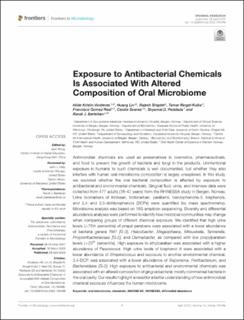| dc.description.abstract | Antimicrobial chemicals are used as preservatives in cosmetics, pharmaceuticals, and food to prevent the growth of bacteria and fungi in the products. Unintentional exposure in humans to such chemicals is well documented, but whether they also interfere with human oral microbiome composition is largely unexplored. In this study, we explored whether the oral bacterial composition is affected by exposure to antibacterial and environmental chemicals. Gingival fluid, urine, and interview data were collected from 477 adults (18–47 years) from the RHINESSA study in Bergen, Norway. Urine biomarkers of triclosan, triclocarban, parabens, benzophenone-3, bisphenols, and 2,4- and 2,5-dichlorophenols (DCPs) were quantified (by mass spectrometry). Microbiome analysis was based on 16S amplicon sequencing. Diversity and differential abundance analyses were performed to identify how microbial communities may change when comparing groups of different chemical exposure. We identified that high urine levels (>75th percentile) of propyl parabens were associated with a lower abundance of bacteria genera TM7 [G-3], Helicobacter, Megasphaera, Mitsuokella, Tannerella, Propionibacteriaceae [G-2], and Dermabacter, as compared with low propylparaben levels (<25th percentile). High exposure to ethylparaben was associated with a higher abundance of Paracoccus. High urine levels of bisphenol A were associated with a lower abundance of Streptococcus and exposure to another environmental chemical, 2,4-DCP, was associated with a lower abundance of Treponema, Fretibacterium, and Bacteroidales [G-2]. High exposure to antibacterial and environmental chemicals was associated with an altered composition of gingiva bacteria; mostly commensal bacteria in the oral cavity. Our results highlight a need for a better understanding of how antimicrobial chemical exposure influences the human microbiome. | en_US |

